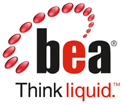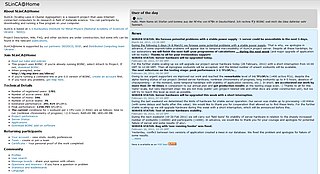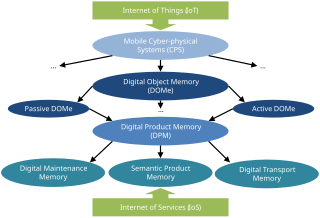
Interoperability is a characteristic of a product or system to work with other products or systems. While the term was initially defined for information technology or systems engineering services to allow for information exchange, a broader definition takes into account social, political, and organizational factors that impact system-to-system performance.
Camunda provides a workflow and decision automation platform offering process orchestration capabilities to organizations of any size. Camunda Platform comes from years of research and development including open source initiatives.

BEA Systems, Inc. was a company that specialized in enterprise infrastructure software products, which was wholly acquired by Oracle Corporation on April 29, 2008.
System of systems is a collection of task-oriented or dedicated systems that pool their resources and capabilities together to create a new, more complex system which offers more functionality and performance than simply the sum of the constituent systems. Currently, systems of systems is a critical research discipline for which frames of reference, thought processes, quantitative analysis, tools, and design methods are incomplete. The methodology for defining, abstracting, modeling, and analyzing system of systems problems is typically referred to as system of systems engineering.

Business process modeling (BPM) in business process management and systems engineering is the activity of representing processes of an enterprise, so that the current business processes may be analyzed, improved, and automated. BPM is typically performed by business analysts, who provide expertise in the modeling discipline; by subject matter experts, who have specialized knowledge of the processes being modeled; or more commonly by a team comprising both. Alternatively, the process model can be derived directly from events' logs using process mining tools.
A skilled worker is any worker who has special skill, training, knowledge which they can then apply to their work. A skilled worker may have learned their skills through work experience, on-the-job training, an apprenticeship program or formal education. These skills often lead to better outcomes economically. The definition of a skilled worker has seen change throughout the 20th century, largely due to the industrial impact of the Great Depression and World War II. Further changes in globalisation have seen this definition shift further in Western countries, with many jobs moving from manufacturing based sectors to more advanced technical and service based roles. Examples of formal educated skilled labor include engineers, scientists, doctors and teachers, while examples of informal educated workers include crane operators, CDL truck drivers, machinists, drafters, plumbers, craftsmen, cooks and bookkeepers.
Open-source governance is a political philosophy which advocates the application of the philosophies of the open-source and open-content movements to democratic principles to enable any interested citizen to add to the creation of policy, as with a wiki document. Legislation is democratically opened to the general citizenry, employing their collective wisdom to benefit the decision-making process and improve democracy.
The Framework Programmes for Research and Technological Development, also called Framework Programmes or abbreviated FP1 to FP9, are funding programmes created by the European Union/European Commission to support and foster research in the European Research Area (ERA). Starting in 2014, the funding programmes were named Horizon.
Electronic participation (e-participation) refers to the use of ICT in facilitating citizen participation in government-related processes, encompassing areas such as administration, service delivery, decision-making, and policy-making. As such, e-participation shares close ties with e-government and e-governance participation. The term's emergence aligns with the digitization of citizen interests and interactions with political service providers, primarily due to the proliferation of e-government.
The Semantic Interoperability Community Europe (SEMIC.EU) was an eGovernment service initiated by the European Commission and managed by the Interoperable Delivery of European eGovernment Services to public Administrations, Businesses and Citizens (IDABC) Unit. As one of the 'horizontal measures' of the IDABC, it was established as a permanent implementation of the principles stipulated in the 'European Interoperability Framework' (EIF). It offered a service for the exchange of semantic interoperability solutions, with a focus on demands of eGovernment in Europe. Through the establishment of a single sharing and collaboration point, the European Union wanted to resolve the problems of semantic interoperability amongst the EU member states. The main idea behind the service was to make visible specifications that already exist, so as to increase their reuse. In this way, governmental agencies and developers benefit as they do not reinvent the wheel, they reduce development costs, and increase the interoperability of their systems.
Business process management (BPM) is the discipline in which people use various methods to discover, model, analyze, measure, improve, optimize, and automate business processes. Any combination of methods used to manage a company's business processes is BPM. Processes can be structured and repeatable or unstructured and variable. Though not required, enabling technologies are often used with BPM.
Design for All in the context of information and communications technology (ICT) is the conscious and systematic effort to proactively apply principles, methods and tools to promote universal design in computer-related technologies, including Internet-based technologies, thus avoiding the need for a posteriori adaptations, or specialised design.
The European Interoperability Framework (EIF) is a set of recommendations which specify how administrations, businesses and citizens communicate with each other within the European Union and across Member State borders.
INDECT is a research project in the area of intelligent security systems performed by several European universities since 2009 and funded by the European Union. The purpose of the project is to involve European scientists and researchers in the development of solutions to and tools for automatic threat detection through e.g. processing of CCTV camera data streams, standardization of video sequence quality for user applications, threat detection in computer networks as well as data and privacy protection.

SLinCA@Home was a research project that uses Internet-connected computers to do research in fields such as physics and materials science.
Model Driven Interoperability (MDI) is a methodological framework, which provides a conceptual and technical support to make interoperable enterprises using ontologies and semantic annotations, following model driven development (MDD) principles.

A digital object memory (DOMe) is a digital storage space intended to keep permanently all related information about a concrete physical object instance that is collected during the lifespan of this object and thus forms a basic building block for the Internet of Things (IoT) by connecting digital information with physical objects.

Joinup is a collaboration platform created by the European Commission. It is funded by the European Union via its Interoperability Solutions for Public Administrations Programme.
Cloud-based design and manufacturing (CBDM) refers to a service-oriented networked product development model in which service consumers are able to configure products or services and reconfigure manufacturing systems through Infrastructure-as-a-Service (IaaS), Platform-as-a-Service (PaaS), Hardware-as-a-Service (HaaS), and Software-as-a-Service (SaaS). Adapted from the original cloud computing paradigm and introduced into the realm of computer-aided product development, Cloud-Based Design and Manufacturing is gaining significant momentum and attention from both academia and industry.
In Azerbaijan, migration policy is handled by the State Migration Service, and appropriate departments of Ministry of Labor and Social Protection of Population, Ministry of Healthcare, Ministry of Foreign Affairs, Ministry of İnternal Affairs, State Border Service, State Committee of Republic of Azerbaijan for Refugees and IDPs and State Security Service. Migration Code, Law on Citizenship, Law on Immigration are the foundations of migration policy in Azerbaijan. An independent migration office - State Migration Service was established on March 19, 2007 to regulate fast-paced migrant and prepare comprehensive and efficient migration policies.





